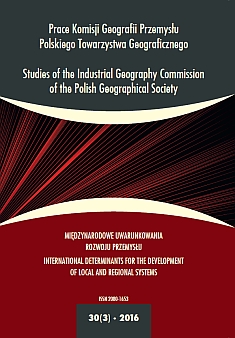Contemporary Changes in the Role and Spatial Structure of Industrial Production in Hungary
DOI:
https://doi.org/10.24917/20801653.303.10Słowa kluczowe:
Hungarian industry, industrial development, industrial parks, industrial production, spatial structure, territorial structural changesAbstrakt
The aim of our paper is to offer a brief survey of the stages of development of industrial productionin Hungary and the transfomation that followed the changing of Hungary’s political system, as well as the maintrends in the contemporary process of re-industrialization. Hungarian industry has long traditions; as early asthe beginning of the 20th century, in certain branches, it was among the leading countries in the world. Afterthe fall of the centrally planned economy of the communist system and following the crisis treatment policiesof the post-communist years, Hungarian industry, today, has to survive in an open economy. The process ofre-industrializaton in Hungary is, basically, an integral part of global industrial change while, at the same time,it is largely dependent on local industrial developments. The volume indices, the value of industrial investmentsand the number of employees in industry, are all indicators of a positive change. The processing industryrepresents a considerable proportion of industrial production in Hungary and, in addition, vehicle manufacturingis the most dynamically developing segment. At the same time, industry in Hungary can still be characterizedby a dual structure; more than two thirds of its production value us produced by large companies.Small- and medium-sized companies have the possibility of being integrated into the production structure assuppliers. Some of Hungary’s traditional industrial branches have deteriorated, while other segments havebeen able to change their structure and become dynamic again. The main focus of industrial production - dueto capital investments by foreigners - has shifted towards the west, and the largest portion of its productionvalue now comes from Hungary’s western and central Transdanubian regions. The process of re-industralizationis beneficial for those regions in which there is an adequate and ready supply of human resources.Downloads
Metrics
Bibliografia
Barta, Gy. (2002). A magyar ipar területi folyamatai 1945–2000. Budapest-Pécs: Dialóg-Campus Kiadó.
Barta, Gy., Czirfusz, M., Kukely, Gy. (2008). Újraiparosodás a nagyvilágban és Magyarországon. Tér és Társadalom, 22(4), 1–20.
Bíró, Cs. (2015, April 30). Top 100 autóipari beszállító – full list. Retrieved from: http://www. autopro.hu/beszallitok/Top-100–autoipari-beszallito-teljes-lista/14390/
Bod, P. Á. (2014). Nem szokványos gazdaságpolitikák. Budapest: Akadémiai Kiadó.
Bora, Gy. (1986). Ipar. In T. Bernát (ed.). Magyarország gazdaságföldrajza. Budapest: Kossuth Könyvkiadó, 79–156.
Botos, B. (2010). Az iparpolitika metamorfózisa. Budapest: L’Harmattan Kiadó.
Csath, M. (2007). The Competitiveness of Economies: the Case of Hungary. In J. Jabłoński (ed.). Foundations of Control and Management Sciences. Poznan: Poznan University of Technology, 17–32.
Enyedi, Gy. (1993). Az Alföld fejlődésének perspektívái. In J. Timár (ed.). Az „alföldi út” kérdőjelei. Békéscsaba: MTA RKK ATI Békéscsabai Osztály, 13–16.
Gulyás, L. (2010). Trianon hatása a Kárpát-medence régióinak fejlődésére. Közép-Európai Közlemények, 3(4), 140–147.
Günther, J. (2002). FDI as a multiplier of modern technology in Hungarian industry. Intereconomics. 37(5), 263–269.
Győri, F. (2011). Tehetségföldrajz: Magyarországi vizsgálatok. Szeged: Egyesület Közép-Európa Kutatására.
Hajdú, Z. (1996). Törtneti földrajzi folyamatok. In Gy. Perczel (ed.). Magyarország társadalmigazdasági földrajza. Budapest: ELTE Eötvös Kiadó, 64–146.
Kiss, É. (2008). A magyar ipar térbeli szerkezetének átrendeződése 1989 után, II. Területi Statisztika, 48(5), 544–553.
Kiss, É. (2009). Industry. In K. Kocsis & F. Schweitzer (eds.). Hungary in Maps. Budapest: Hungarian Academy of Sciences Geographical Research Institute, 153–163.
Kiss, É. (2011). Ipar. In K. Kocsis & F. Schweitzer (eds.). Magyarország térképekben. Budapest: MTA Földrajztudományi Kutatóintézet, 176–188.
Kiss, É. (2013). Sokszínű ipari parkállomány. In. É. Kiss (ed.). A hazai ipari parkok különböző dimenzióban. Budapest-Pécs: Dialóg Campus, 11–39.
Központi Statisztikai Hivatal (2014). Jelentés az ipar 2013. évi teljesítményéről. Budapest: Központi Statisztikai Hivatal. Retrieved from: http://www.ksh.hu/docs/hun/xftp/idoszaki/ jelipar/jelipar13.pdf
Központi Statisztikai Hivatal (2016, March 24) Ipar. Budapest: Központi Statisztikai Hivatal. Retrieved from: https://www.ksh.hu/ipar_t
Kukely, Gy. (2004). A területi és ágazati struktúra átalakulása a magyar ipar húzóágazatában, a gépiparban. Földrajzi Értesítő, 53(1–2), 93–100.
Mihályi, P. (2011). A magyar privatizáció enciklopédiája. Budapest: Pannon Egyetemi Kiadó – MTA Közgazdaságtudományi Intézet.
Mihályi, P. (2012). The Causes of Slow Growth in Hungary during the Post-Communist Transformation Period. Budapest: Institute of Economics, Research Centre for Economic and Regional Studies, Hungarian Academy of Sciences.
Nemes Nagy, J. (1992). Margójegyzetek a regionális politikához. Tér és Társadalom, 6(1–2), 69– 76.
Pál, Á. & Pál, V. (2009). Magyarország ipari térszerkezetének változása, különös tekintettel az Alföldre. In Sz. Tóth (ed.). Tudományos és művészeti műhelymunkák. Szeged: SZTE JGY Kiadó, 321–328.
Perczel, Gy. (1996). Ipar. In G. Perczel (Ed). Magyarország társadalmi-gazdasági földrajza. Budapest: ELTE Eötvös Kiadó, 284–370.
Probáld, F. (2011). A gazdaság általános jellemzői. In K. Kocsis & F. Schweitzer (eds.). Magyarország térképekben. Budapest: MTA Földrajztudományi Kutatóintézet, 139–147.
Szijártó, N. (2012). Hogyan lett az iparpolitikából vállalkozáspolitika? Magyar alkalmazkodás az Európai Unió struktúrapolitikájához (ipar- és vállalkozáspolitikájához) – tanulságok. Közgazdaság: tudományos füzetek, 3(4), 33–49.
Pobrania
Opublikowane
Jak cytować
Numer
Dział
Licencja
Artykuły publikowane są zgodnie z warunkami licencji Creative Commons (CC BY-ND 4.0; uznanie autorstwa-bez utworów zależnych).

